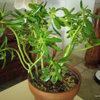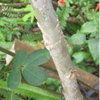mangosteen
August 9, 2006
Forbidden? Not the Mangosteen
By DAVID KARP
LAS VEGAS, P.R.
PERCHED on a dizzyingly steep slope, in a lush landscape dotted with waterfalls and tall bamboo, Ian Crown celebrated the vindication of what he called his madness in a patch in the jungle. He rustled through the thick, glossy leaves of a nine-foot-tall tree, plucked a reddish-purple orb, cut around its equator, twisted off a hemisphere of thick rind, and popped a few delicate, snow-white segments into his mouth.
"Ive waited so long for this moment," he said in July, savoring the floral, sweet-tart flavor of one of the most delicious of fruits, and certainly the most hyped: the mangosteen.
For decades it has been famously, tantalizingly unavailable on the United States mainland, but Mr. CrownÂs Panoramic Fruit Company has sent several test shipments in the past month to New York and Los Angeles. Sherry Yard, the pastry chef at Spago Beverly Hills, was thrilled to be able to taste a few. "This is like seeing a unicorn," she said.
By next summer Mr. Crown hopes to be the first producer in decades to ship fresh mangosteens to the mainland commercially.
Native to Indonesia and Malaysia, mangosteen trees require a highly tropical, humid climate, and they cannot be grown commercially in the contiguous United States, although a few determined enthusiasts have coddled them to fruiting in the warmest parts of Florida.
Because fresh mangosteens can harbor insect pests, the Department of Agriculture prohibits their being brought from the main countries that grow them in Southeast Asia, or from Hawaii. (Mangosteens smuggled from Canada, where they are permitted because tropical pests cannot survive there, are occasionally sold in Chinatown.)
But contrary to its reputation as a forbidden fruit, the mangosteen can be imported legally from 18 Caribbean and Central America countries, as well as from Puerto Rico. Until recently, however, no one cultivated them commercially in those areas.
Enter Mr. Crown, 54, a doctorÂs son with a bachelorÂs degree in agriculture from Cornell University. After working for garden centers he became a commodities broker, and now is a private investor living in Connecticut with his wife and two cats.
In 1994, beguiled by the romance of old coffee mansions in the jungle, he looked to invest in a Puerto Rican farm. While researching crops to provide shade for coffee trees, he became excited by the promise of exotic fruit farming, and bought a 94-acre livestock ranch in the foothills east of Mayagüez, which he planted with mangosteen, rambutan, longan and other Asian fruits.
Mangosteen (Garcinia mangostana) is difficult to propagate by convenient methods like grafting, and when raised from seed takes 8 to 10 years or longer to bear fruit, a major disincentive for aspiring growers.
"ItÂs incredibly irritating," Mr. Crown said.
After much searching he obtained mangosteen seeds and seedlings from Hawaii and Florida, babied the young trees for two years in a shaded nursery, and planted them on his farm. He then found, to his dismay, that young mangosteens have weak roots. At the time he did not have irrigation, and more than half died. "The attrition was terrible," he said. "I learned everything the Âtwo-by-four in the forehead way."
Things got worse. In 1997 local youths burned most of his plantings to the ground, and in 1998 Hurricane Georges swept through like "a weed whacker combined with a vacuum cleaner," he said. He was devastated, but started over from scratch.
Now, finally, he is rejoicing in his first real mangosteen harvest. Of the 1,000 mangosteen trees scattered around his property  they would fill 10 acres if planted together  35 trees bore a total of 200 pounds in July. Future yields should increase exponentially. (Several exotic fruit buffs in his area grow mangosteens, but no one else in Puerto Rico has a commercial orchard.)
Despite their thick rinds, mangosteens need pampering, and even then can develop problems like gamboge, a bitter yellow resin that seeps into the pulp, and translucent flesh, which can be caused by fluctuating rains and high humidity.
When commercial sales start next year, Mr. Crown will send the fruit by FedEx, after federal inspection, to two specialty produce distributors, Baldor in New York and MelissaÂs in Los Angeles.
"IÂd love to be able to put them on the menu," Sébastien Rouxel, the pastry chef at Per Se, said after tasting samples.
Mr. CrownÂs venture is the latest chapter in the century-long saga of Americans craving and attempting to grow mangosteen.
It first was planted in Puerto Rico in 1903, and a 1925 article in The New York Times trumpeted that this "wondrous fruit of the East" would soon be available on the mainland from tropical America. But in 1963 another article lamented that "it remains as scarce as ever." In 1970 Lincoln A. Martin, a mangosteen aficionado, imported considerable quantities from the United Fruit planting in Lancetilla, Honduras, then the largest in the Western Hemisphere. The fruit "made quite a splash," recalled Frieda Caplan, the distributor; but it required fumigation, which made it susceptible to rapid spoilage, curtailing the experiment, Mr. Martin said.
By next year there may be other sources of mangosteen in the United States as well. On July 26 the Agriculture DepartmentÂs Animal and Plant Health Inspection Service published a proposed rule to allow fresh mangosteen and five other fruits to be imported from Thailand after being irradiated, which sterilizes insect pests. Final approval of the rule would take at least six months, possibly a year, said Inder Paul Gadh, senior risk manager for the agency.
Thailand, which has 115,000 acres of mangosteens, hopes to complete a commercial irradiation facility by next summer  peak mangosteen season  said Rapibhat Chandarasrivongs, agricultural minister-counselor at the Thai Embassy in Washington.
Mr. Crown said that he anticipated the cheaper imports and that he should be able to compete with them by selling fresher, nonirradiated fruit.
Fresh mangosteen may just be starting to arrive here, but since 2002, nutritional supplement purveyors have aggressively marketed high-priced mangosteen juice blends for their purported medical benefits, fueling an improbable boom. Southeast Asians have long used mangosteen rind as a traditional remedy for various ailments, and laboratory studies indicate that chemicals in the rind called xanthones show promise in combating bacteria, fungi, inflammation, free radicals and cancer.
So far there have been only very few tests on animals, and no human clinical trials, but many vendors make unsubstantiated claims, based largely on anecdotal evidence.
Many purveyors sell through multilevel marketing, a sometimes controversial business model in which distributors earn commissions from new recruits. Mangosteen elixirs, made with purées of the whole fruit, are pricey, ranging from $17 to $40 for about 24 ounces, especially since they primarily contain other fruit juices and have little mangosteen flavor.
Nevertheless, seizing on the recent vogue for exotic "fruitaceuticals" like noni, goji, and açaÃ, mangosteen beverage sellers have flourished, particularly XanGo, a private company that says it has 600 employees, and 500,000 independent distributors worldwide.
XanGo does not disclose sales, but Grant Ferrier, editor of Nutrition Business Journal, estimated that the company sold $200 million of mangosteen beverages in 2005 worldwide, and accounted for 80 percent of the domestic market. Other brands, like Mango-xan, are sold directly at health food stores and groceries; in June, Adam Heller, another mangosteen maven, began selling pure juice at mangosteens.com.
Mr. Crown, who reserved the domain name mangosteen.com in 1998 and recently began using that site to educate customers, said he has been bombarded with requests by supplement marketers to buy the siteÂs name. He has no intention of selling, and is skeptical about medical claims for mangosteen. Indeed, at the moment of his triumph he is suspended between elation and paranoia, afraid of intruders on his farm and of being hounded by desperate mangosteen fans while his trees are taking their own sweet time to bear fruit.
"IÂm mulling going into hiding," he said.
ThereÂs something about the mangosteen, amplified by its longtime unavailability, that has driven its devotees to obsession and hyperbole. Thus Rudyard Kipling wrote in 1902, entranced by the fruitÂs mystique, "YouÂll know what my riddle means / When youÂve eaten mangosteens."
Copyright 2006 The New York Times Company








sonotaps
Eggo
Related Professionals
Folsom Landscape Architects & Landscape Designers · Panama City Landscape Architects & Landscape Designers · Zion Landscape Architects & Landscape Designers · Edmond Landscape Contractors · Elgin Landscape Contractors · Cudahy Landscape Contractors · Euclid Landscape Contractors · Fort Worth Landscape Contractors · Lake Zurich Landscape Contractors · Lees Summit Landscape Contractors · McLean Landscape Contractors · Parker Landscape Contractors · Pomona Landscape Contractors · Greenfield Landscape Contractors · Sun Valley Landscape Contractorsohiojay
tropicaliste
ohiojay
tropicaliste
ohiojay
tropicaliste
ohiojay